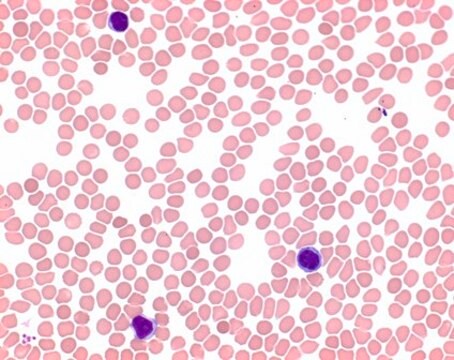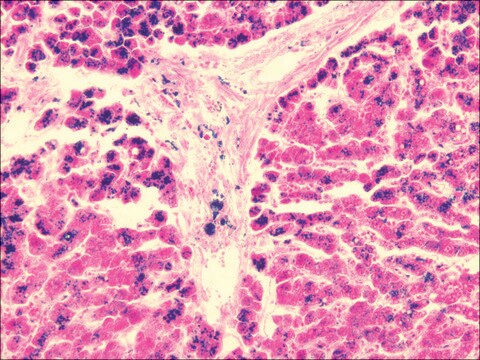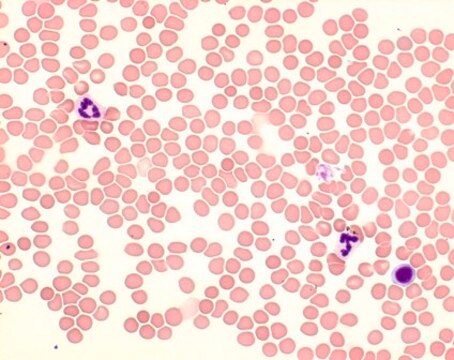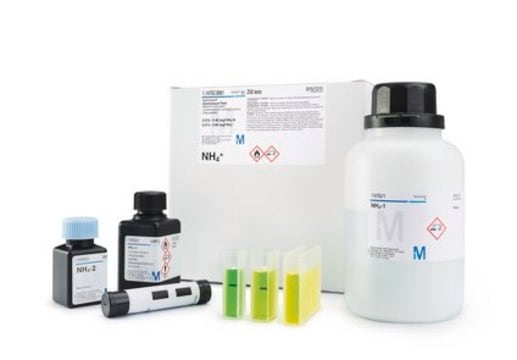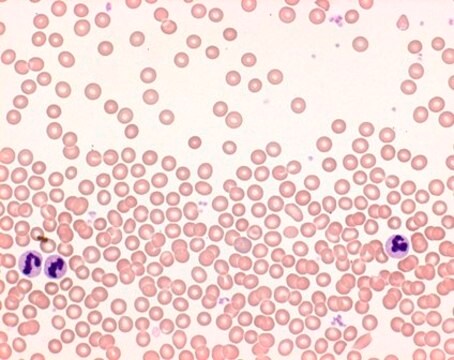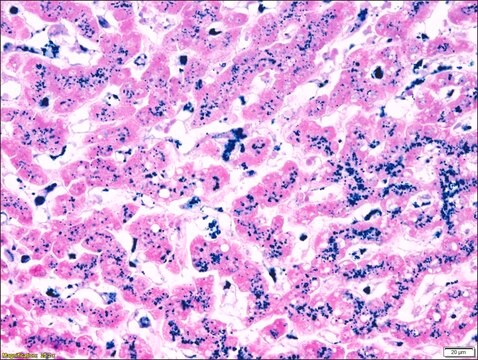1.12084
HEMATOGNOST Fe™
staining kit for the detection of free ionic iron (Fe³⁺) in cells
Se connecterpour consulter vos tarifs contractuels et ceux de votre entreprise/organisme
About This Item
Code UNSPSC :
41116121
Produits recommandés
Niveau de qualité
IVD
for in vitro diagnostic use
Application(s)
clinical testing
diagnostic assay manufacturing
hematology
histology
Température de stockage
15-25°C
Catégories apparentées
Description générale
HEMATOGNOST Fe™ - staining kit for the detection of free ionic iron (Fe3+) in cells, is used for human-medical cell diagnosis and serves the purpose of the hematological and histological investigation of sample material of human origin. HEMATOGNOST Fe™ is a staining kit for performing the so-called Prussian blue (Berlin blue) reaction in hematological and histological specimen material. This staining kit contains all the reagents necessary for the detection of free ionic iron. In the Prussian blue reaction, ionic iron (Fe3+) not bound to the heme structure reacts with potassium hexacyanoferrate(II) in hydrochloric solution. It precipitates as an insoluble complex salt in the blood, bone-marrow, or tissue cells and thus localizes free cellular iron: 4 Fe3+ + 3 K4Fe(CN)6 = Fe4[Fe(CN)6]3 + 12 K+
As a measure to achieve the best possible visual differentiation of the iron deposits in the cytoplasma, this is counterstained with nuclear fast red solution (Nuclear fast red-aluminum sulfate solution 0.1% (Product number 1.00121), resulting in a tender pink color. If further, more detailed information on the cell morphology is required, counterstaining with any of the other familiar “classical” methods such as Giemsa, (Giemsa, Product number 1.09204), May-Grünwald (May-Grünwald eosin methylene blue solution, Product number 1.01424), hemalum (Mayer′s hemalum solution, Product numer 1.09249), etc. can also be employed.
The Prussian blue reaction can also be used to stain specimens already stained by one of these classical procedures for the additional detection of iron. Repeat counterstaining is not necessary in this case.
The staining kit is sufficient for 6 - 8 stainings with up to 16 slides. The staining kit is developed and registered as CE / IVD product for applications in diagnostics. For more details, please see instructions for use (IFU). The IFU can be downloaded from this webpage.
As a measure to achieve the best possible visual differentiation of the iron deposits in the cytoplasma, this is counterstained with nuclear fast red solution (Nuclear fast red-aluminum sulfate solution 0.1% (Product number 1.00121), resulting in a tender pink color. If further, more detailed information on the cell morphology is required, counterstaining with any of the other familiar “classical” methods such as Giemsa, (Giemsa, Product number 1.09204), May-Grünwald (May-Grünwald eosin methylene blue solution, Product number 1.01424), hemalum (Mayer′s hemalum solution, Product numer 1.09249), etc. can also be employed.
The Prussian blue reaction can also be used to stain specimens already stained by one of these classical procedures for the additional detection of iron. Repeat counterstaining is not necessary in this case.
The staining kit is sufficient for 6 - 8 stainings with up to 16 slides. The staining kit is developed and registered as CE / IVD product for applications in diagnostics. For more details, please see instructions for use (IFU). The IFU can be downloaded from this webpage.
Remarque sur l'analyse
Potassium hexacyanoferrate II (Reagent 1): 4.5 - 5.5 %
Hydrochloric acid (Reagent 2): 4.5 - 5.5 %
Density (Reagent 3 d 20 °C/4 °C): 1.040 - 1.060
Suitability for microscopy: passes test
Hydrochloric acid (Reagent 2): 4.5 - 5.5 %
Density (Reagent 3 d 20 °C/4 °C): 1.040 - 1.060
Suitability for microscopy: passes test
Informations légales
HEMATOGNOST FE is a trademark of Merck KGaA, Darmstadt, Germany
Mention d'avertissement
Danger
Mentions de danger
Conseils de prudence
Classification des risques
Eye Dam. 1 - Met. Corr. 1
Code de la classe de stockage
8B - Non-combustible, corrosive hazardous materials
Classe de danger pour l'eau (WGK)
WGK 1
Point d'éclair (°F)
Not applicable
Point d'éclair (°C)
Not applicable
Certificats d'analyse (COA)
Recherchez un Certificats d'analyse (COA) en saisissant le numéro de lot du produit. Les numéros de lot figurent sur l'étiquette du produit après les mots "Lot" ou "Batch".
Déjà en possession de ce produit ?
Retrouvez la documentation relative aux produits que vous avez récemment achetés dans la Bibliothèque de documents.
Notre équipe de scientifiques dispose d'une expérience dans tous les secteurs de la recherche, notamment en sciences de la vie, science des matériaux, synthèse chimique, chromatographie, analyse et dans de nombreux autres domaines..
Contacter notre Service technique